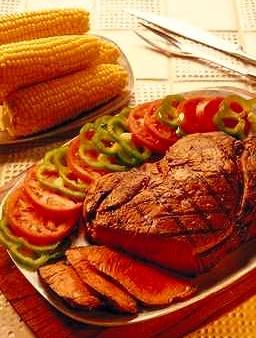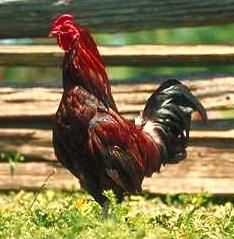
















The Importance of Food
Copyright © August 10, 2015 by Robert Wayne Atkins, P.E.
All Rights Reserved.
Introduction
 Most people know that the Rule of Threes states that a person can live for:
Most people know that the Rule of Threes states that a person can live for:
three-minutes without air,
three-days without water, and
three-weeks without food.
The importance of water is discussed in the following article on my website: "How to Find Water and How to Make Water Safe to Drink."
This article will focus on the importance of food.
Food is one of the three basic necessities of life. If you have clean fresh air and clean fresh water, but you don't have any food, then you will starve to death in less than a month.
Most people do not truly appreciate how reasonably priced food is in most countries around the world. When I use the term "reasonably priced" I mean in comparison to the effort required to produce that food. With today's modern farming methods and livestock management techniques it requires a lot less land and a lot less manual effort to produce food when compared to just 100 years ago.
On the other hand, when food or water become relatively scarce, or expensive, then a government will sometimes use food (or water) to control and manipulate its citizens. This has happened many times during the past 100 years in a variety of countries all around the world. A summary of a book that was written on this topic is on my website here: "Man and Society in Calamity."
Food Acquisition
There are several ways that food can be obtained as follows:
- Buy food as you need it: This is how most people acquire their food. They buy just enough food to last them until the next time they plan to go to the store. This strategy actually does work for some people their entire lives. However, to believe that this strategy will continue to work during a hard times disaster event is not very realistic.
- Buy long-term storage food: This is an investment that some people make in order to keep their family alive during a future emergency situation. These people may never need their long-term storage food. However, this strategy is similar to buying fire insurance on your home. You sincerely pray that your home will never burn to the ground -- but if it does then your family will have the benefit of having your home replaced by the fire insurance company. People who buy long-term storage food hope they will never need it. However, if a future disaster event should occur, then their family will have food to eat.
- Grow your own vegetables:

- Very Small Scale: Growing a few vegetables in a pot in front of a window that gets good sun during the day is a very good idea. The amount of work is relatively small and if your vegetables don't do well then it will have no impact on your life. If your vegetables do grow well then you can eat them with the satisfaction of knowing that you grew them yourself. However, regardless of how well your vegetables grow, you will still be gaining some practical experience on a regular basis on how to provide one of the three basic necessities of life. This knowledge and experience could be of significant value to you at some time in the future.
- Medium to Large Scale: Trying to grow enough vegetables to feed your family for an entire year requires a lot of space and a lot of time and effort. However, this is a reasonable option if you need the exercise, and if you have the space and the time to grow a lot of vegetables, and if you know how to preserve your vegetables for future consumption during the winter months. On the other hand, if you have a full-time job then this is not a good option because you can purchase the food you need at the store for less money than you would invest in growing those same vegetables yourself.
- Purchase and take care of a few farm animals:

- Goats: Most people think that raising goats is relatively easy and that they will yield a continuous supple of fresh milk that can be easily converted into butter or cheese. However, goat's milk does not contain as much cream as cow's milk so making goat butter is relatively complicated and it is not easy. If you wish to make cheese then you will need some lemon juice. A dairy goat will give milk for about 10 months, and then she should be allowed to rest for about 2 months. Then she should be mated and approximately 5 months later she will give birth and start producing milk again. Therefore you will be providing water, food, and care for a female goat for approximately 17 months but you will only be receiving milk for about 10 of those 17 months. You will need to trim the hooves of the goats every month or two. And you will also occasionally be butted by a goat for no particular reason and you will not appreciate the pain. You will also need to provide veterinary care for the goats when it is needed. The veterinarian fee will offset whatever money you thought you were saving in raising goats for milk, cheese, and meat. In my opinion, goats are not a good choice. Most people would be better advised to invest the money they were going to spend on goats, and in taking care of those goats, on instant dry milk in long-term storage cans. (Note: Most people who keep dairy goats do not own their own male goat. Male goats can be more temperamental than a female goat and their only function is to mate with a female goat approximately once every 17 months. Therefore the cost and the challenges of keeping a male goat far exceeds the value of the male goat unless you are able to hire out the male goat to lots and lots of other families as a stud goat. When a female goat gives birth to a male goat then the male goat is usually raised for about 3 or 4 months and then it is old enough to be slaughtered and eaten.)

- Rabbits: The internet is full of advice on how easy it is to raise rabbits for food. However, you will need at least one female rabbit and one male rabbit. After a female rabbit has mated with a male rabbit, it takes the female rabbit about one-month to give birth to one or more tiny baby rabbits. Some female rabbits will nurse their young but some female rabbits will push their newborn babies over into a corner of their cage and then ignore them and let them die. If the female does nurse her babies then it will take about 1.5 to 2 months before the baby rabbit can be weaned and it is able to eat normal rabbit food. It will then take an additional 4 to 6 more months for the rabbit to grow big enough to provide enough meat for one meal. During this entire 8 month period you will have to provide water and food for the rabbit, and you will have to clean up the rabbit poop and urine on a regular basis. Rabbits will also occasionally get sick and you will have to try to cure the rabbit yourself, or you will have to take the rabbit to a veterinarian. The veterinarian fee will offset whatever money you thought you were saving in raising rabbits for meat. For all of these reasons I do not recommend raising rabbits for food.

- Chickens: Female chickens will lay about 5 eggs per week, regardless of whether or not you have a rooster. However, unless you have a rooster those eggs will not be fertile. They will be like the eggs you buy at a grocery store which are produced in a rooster-free environment. If you have fertile eggs then some female chickens will sit on their eggs and hatch them. However, it is not unusual for the other chickens to attack and kill the baby chickens so the mother chicken has to be constantly present to protect her young. Therefore if you are going to keep chickens then I suggest that you gather their freshly laid eggs twice a day. When the adult female chickens are about one-year old then you should consider replacing them. You can hatch fresh fertile eggs in an egg incubator, and then raise those baby chickens in a special area following the instructions that are explained in any book about raising chickens. When the baby chickens are about three months old you can put them in the adult chicken coop. Approximately half of the chickens will be female and half will be male. When the male roosters are about three or four months old they will be big enough for you to slaughter them and eat them. You can allow one or two of the biggest and healthiest male roosters to live to provide fertile eggs in the future. As the young female chickens continue to grow you can gradually kill and eat the mature chickens that are already more than a year old. At the age of approximately five months the new female chickens will begin laying eggs. You can allow them to produce eggs for you until they get to be about a year old, and then you can replace them with some more chickens that you hatch yourself. You will need to provide fresh water and chicken feed (and grit) for the chickens and you will need to remove the chicken poop from the chicken coop on a regular basis. If you have a rooster then it will make itself known every morning before you are ready to wake up, and depending on the terrain in your area, the rooster can usually be heard in every direction for about one-half mile. (Note: During a serious long-term disaster event the rooster will draw every starving person without hearing range to your location and you will either lose your chickens during the night or you will lose your life trying to protect your chickens.)
- Harvest edible wild plants: Most survival manuals have a very long list of wild plants that can be safely eaten. However, there are three problems with these types of edible wild plants:
- Availability: The majority of the edible wild plants that are mentioned in survival manuals do not grow everywhere. Instead each one only grows in specific areas. On the average, only a limited number of edible wild plants grow in a specific region. However, there are some exceptions.
- Quantity: In many cases the edible wild plants do not grow in abundance. When they can be found there is usually only enough of the plant for one meal. However, there are some exceptions.
- Nutrition: Even though a wild plant may be edible it usually does not contain the calories or the vitamins necessary to keep a person healthy. However, there are exceptions.
It is not practical to believe that a family could survive for very long on the edible wild plants that may be growing in their vicinity. However, a family may be able to supplement their meals occasionally with a few edible wild plants. The most common edible wild plants that are easy to recognize and that grow in a lot of different areas are the following: white oak acorns, hickory nuts, kudzu, and poke sallet. Recipes for these wild foods are on my website and they are also in my cookbook. In addition, my cookbook Grandpappy's Recipes for Hard Times also contains recipes for some edible wild plants that are not mentioned on my website, such as cattails, evergreen pine needles, clover, daisies, and dandelions.

- Eat wild game animals: If you live in an area that is populated with edible wild game animals then you may be able to supplement your meals occasionally with properly prepared and cooked wild game animals, such as squirrels. Instructions on how to butcher, prepare, and cook a variety of wild game animals are on my website and these instructions are also in my cookbook. Although these animals can be hunted with a bow and arrow or a modern firearm, I believe that most people will have greater success using traps and snares. During a serious hard times disaster event the wild game population in an area will be quickly harvested by the starving people in that area. Therefore a family should not be depending on wild game animals as a continuous steady supply of meat.
- Steal food: During a long-term disaster event the people who will be trying to steal food will consist of two groups of people as follows:
- Thieves: These are the people who have carefully considered the impact of a future long-term disaster event and they have already decided that they will simply steal the food they need.
- Normal People: These are the people who have never given any serious thought to the potential impact of a long-term disaster event and if that event should happen then they will suddenly realize that the only way their family will survive is if they begin stealing food.
Therefore the total number of people who will be trying to survive on stolen food will far exceed the amount of food that is available in any area.
- Cannibalism: Cannibalism is mentioned in the Holy Bible as the undesirable result of a long-term famine. However, eating other people has never been a pleasant thing to think about. Historically cannibalism has always occurred during serious long-term famines and there is no reason to believe that it will not happen again in the future. Even though eating the flesh of people causes serious long-term mental problems and health problems, some people will become cannibals when there is nothing else to eat and starvation is the only other option.
Conclusion
 If a family were to plant their own vegetable garden, or try to raise a few farm animals for food, then that family would quickly realize that the amount of time, effort, and money they invested in producing their own food is a lot more than the price of that same amount of food at the store. The reason is due to economies of scale.
If a family were to plant their own vegetable garden, or try to raise a few farm animals for food, then that family would quickly realize that the amount of time, effort, and money they invested in producing their own food is a lot more than the price of that same amount of food at the store. The reason is due to economies of scale.
There are also a wide variety of problems that can impact a family's effort to produce their own food. For example, drought, floods, insects, diseases, bad weather, and wild animals and birds can destroy a family's vegetable garden and kill off their livestock. In addition, during a long-term disaster event the starving people in your area will steal your vegetables and slaughter your farm animals during the night.
Therefore the only reasonable option for feeding your family during a future hard times disaster event is to purchase and store some emergency food in your home before the event occurs.
Some detailed information on emergency storage foods is discussed in the following articles on my website:
- Long-Term Food Storage.
- An Affordable One-Year Emergency Food Supply.
- Freeze Dried and Dehydrated Foods.
Respectfully,
Grandpappy.
Grandpappy's e-mail address is: RobertWayneAtkins@hotmail.com




































 Most people know that the Rule of Threes states that a person can live for:
Most people know that the Rule of Threes states that a person can live for:




 If a family were to plant their own vegetable garden, or try to raise a few farm animals for food, then that family would quickly realize that the amount of time, effort, and money they invested in producing their own food is a lot more than the price of that same amount of food at the store. The reason is due to economies of scale.
If a family were to plant their own vegetable garden, or try to raise a few farm animals for food, then that family would quickly realize that the amount of time, effort, and money they invested in producing their own food is a lot more than the price of that same amount of food at the store. The reason is due to economies of scale.
